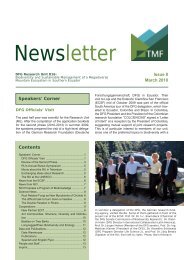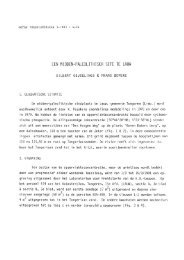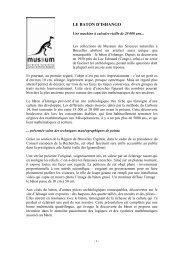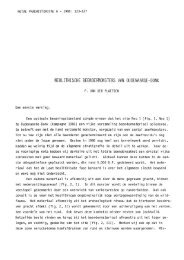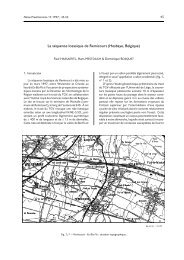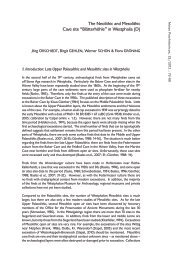Terebratula Daleidensis - Royal Belgian Institute of Natural Sciences
Terebratula Daleidensis - Royal Belgian Institute of Natural Sciences
Terebratula Daleidensis - Royal Belgian Institute of Natural Sciences
Create successful ePaper yourself
Turn your PDF publications into a flip-book with our unique Google optimized e-Paper software.
58 Paul SARTENAER<br />
Strunian), Canada (New Scotland, Pragian), China<br />
(Inner Mongolia, Upper Emsian), England (Siegenian<br />
to Eifelian), France (Gedinnian, Siegenian, Emsian,<br />
Lower Couvinian), Iran (Siegenian to Upper Emsian),<br />
Kazakhstan (Emsian, Eifelian), Libya (Lower Devonian,<br />
Givetian-Lower Frasnian), Mauritania (Siegenian<br />
to Lower Couvinian), Morocco (Lower and Upper<br />
Siegenian, Lower and Upper Emsian, Lower Eifelian),<br />
Poland (Upper Ludlow, Upper Emsian), Rumania<br />
(Gedinnian, Siegenian), Spain (Gedinnian, Siegenian,<br />
Emsian), Turkestan (Upper Devonian), Turkey [Lower<br />
Devonian (Siegenian, Emsian)], Uzbekistan (Upper<br />
Devonian).<br />
Conclusions<br />
Before trying to get out <strong>of</strong> the fix we are in, it is useful<br />
to examine clearly the succession <strong>of</strong> steps that allowed<br />
the confusion to progressively install itself in a process<br />
that is common for many species <strong>of</strong> old standing:<br />
- wrong understanding, and thus incorrect<br />
identifications (<strong>of</strong>ten based on one or two external<br />
characters) that resulted in incorporating <strong>of</strong> various<br />
forms in the Eifel species <strong>Terebratula</strong> daleidensis<br />
and T. hexatoma, and in proposing arbitrary<br />
groupings; the word “group” being used with various<br />
meanings;<br />
- erroneous and not substantiated generic assignments;<br />
- spreading <strong>of</strong> the two species from their loci typici<br />
(Daleiden “Muldengruppe”, and Gerolstein Syncline,<br />
respectively) to other parts <strong>of</strong> the Eifel area, to<br />
other regions <strong>of</strong> Germany (both species: Bergisches<br />
Land, Dill Syncline, Hörre, Harz, Lahn Syncline,<br />
Moselle valley, middle Rhine valley, Sauerland,<br />
Taunus; daleidensis alone: Aachen area, Hessisches<br />
Hinterland, Hunsrück, Kellerwald, Siegerland,<br />
Westerwald), to bordering and near-by regions<br />
(both species: Ardennes, Dinant Basin, France,<br />
Grand Duchy <strong>of</strong> Luxemburg; daleidensis alone:<br />
Vesdre Massif; hexatoma alone: Namur Basin), to<br />
other European countries (both species: England,<br />
Poland, Russia, Spain; daleidensis alone: Rumania;<br />
hexatoma alone: Kuznetsk Basin), and to the rest<br />
<strong>of</strong> the world (both species: Iran, Libya, Mauritania,<br />
Morocco, Uzbekistan; daleidensis alone: Algeria,<br />
China, Kazakhstan, Nova Scotia, Turkey ; hexatoma<br />
alone: Canadian Arctic);<br />
- considerable stratigraphic range: for daleidensis:<br />
Eifel area [Siegenian to Lower Eifelian (chiefly<br />
upper part <strong>of</strong> Lower Emsian, and Upper Emsian)],<br />
other regions <strong>of</strong> Germany [Siegenian to Lower<br />
Eifelian (chiefly Lower and Upper Emsian)], and<br />
other parts <strong>of</strong> the world [Gedinnian to Middle<br />
Eifelian, and Frasnian (chiefly Siegenian to Emsian)]<br />
not to mention exceptional occurrences in beds <strong>of</strong><br />
late Ludlow, Gedinnian, Frasnian, and Strunian<br />
ages; for hexatoma: Eifel area [Lower Emsian to<br />
Givetian (chiefly Upper Emsian to Middle Eifelian)],<br />
other regions <strong>of</strong> Germany (Upper Emsian to Lower<br />
Givetian), and other parts <strong>of</strong> the world (Pragian to<br />
Lower Givetian, Frasnian, and Lower Famennian);<br />
- quasi general lack <strong>of</strong> any information on the precise<br />
location or range <strong>of</strong> species within lithostratigraphic<br />
units, rarely smaller than a formation, with, as a<br />
result, the impossibility to trace eventual transition<br />
forms and to follow evolutionary lineages;<br />
- usual preservation as moulds <strong>of</strong> the fossils obtained<br />
from the Rhenish “Grauwacke” involving more<br />
disadvantages than advantages.<br />
Systematic Palaeontology<br />
Family Sapphicorhynchidae SaRtenaeR, 2007<br />
Genus Oligoptycherhynchus<br />
SaRtenaeR, 1970, emend. 2007<br />
SaRtenaeR (2007, p. 45) acknowledged that “the<br />
wide range (middle Siegenian to Eifelian) advocated<br />
by him in 1970 for Oligoptycherhynchus has become<br />
unacceptable”, with, accordingly, the elimination from<br />
the genus <strong>of</strong> all other species than the type species,<br />
the Middle Eifelian O. hexatomus. The revaluation<br />
<strong>of</strong> the Upper Emsian daleidensis in the present paper<br />
convinced the author that this species had to remain<br />
in the genus, and that its assignment to a new genus<br />
suggested by him (SaRtenaeR, 2009, p. 34) had to be<br />
refuted.<br />
Type species: <strong>Terebratula</strong> hexatoma SchnuR, 1851.<br />
Diagnosis<br />
The emended diagnosis <strong>of</strong> the genus, which is here<br />
assigned to he family Sapphicorhynchidae, is as<br />
follows: medium size; outline subcordiform; uniplicate;<br />
inequivalve; top <strong>of</strong> dorsal valve at front; commissure<br />
sharp; well marked sulcus and fold, starting at a short<br />
distance from the beaks; sulcus moderately deep with<br />
flat to slightly convex bottom, wide at front; high fold<br />
with slightly convex top; high subrectangular tongue<br />
with sharp borders, sometimes recurved posteriorly<br />
in its upper part; ventral beak slightly to strongly



